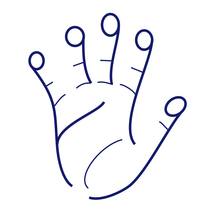Citizen science
H-unique, In search of uniqueness - harnessing anatomical hand variation
H-unique is a five year, €2.5m programme of research that will be the first multimodal automated interrogation of visible hand anatomy, through analysis and interpretation of human variation via images

Active
September 2019
What we are doing
H-unique is a five year, €2.5m programme of research that will be the first multimodal automated interrogation of visible hand anatomy, through analysis and interpretation of human variation via images. It is an interdisciplinary project, supported by anatomists, anthropologists, geneticists, bioinformaticians, image analysts and computer scientists.
Why we are doing it
The project will investigate the inherent and acquired variation in search of uniqueness, as the hand retains and displays a multiplicity of anatomical variants formed by different aetiologies (genetics, development, environment, accident etc). The project has arisen directly from Prof. Sue Black’s ground-breaking research in relation to the forensic identification of individuals from images of their anatomy in child abuse cases.
How we will do it
To help with this research the project shortly be calling on 5,000 ‘citizen scientists’ to contribute images to the world’s first searchable database of the anatomy and variations of the human hand. To register an interest in this exciting initiative please contact the team at the University of Lancaster.
People
Project lead(s)
Professor Lucina HackmanExternal team members
Professor Dame Sue Black
Partners


This project has received funding from the European Research Council (ERC) under the European Union's Horizon 2020 research and innovation programme.
Professor Dame Sue Black
To help with this research the project shortly be calling on 5,000 ‘citizen scientists’ to contribute images to the world’s first searchable database of the anatomy and variations of the human hand. Register an interest in this exciting initiative through the team at the University of Lancaster.
Leverhulme Research Centre for Forensic Science
LRCFSPublicEngagement@dundee.ac.uk